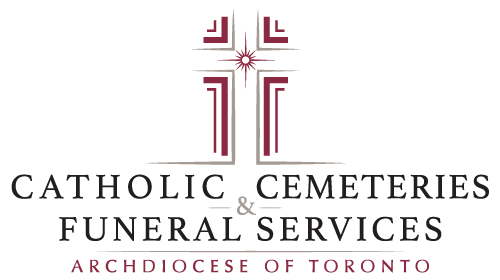The Order of Christian Funerals
The Order of Christian Funerals, published in 1990 by the Canadian Bishops, guides the Catholic community with specific rites and prayers to express consolation to those who grieve, to give thanks to God for the blessings received by and through the deceased and to ask God for mercy on all sinners. It is designed to help confront death in light of the life, suffering, death and resurrection of Jesus. “In the face of death the Church confidently proclaims that God has created each person for eternal life and that Jesus, by his death and resurrection, has broken the chains of sin and death that bound humanity.” (The Order of Christian Funerals #1)
Funerals for Catholics have three distinct parts:
The Vigil
“At the death of a Christian, whose life was begun in the waters of Baptism and strengthened at the Eucharistic table, the Church intercedes on behalf of the deceased because of its confident belief that death is not the end nor does it break the bonds forged in life.” (OCF #4)
The time immediately following death is often one of bewilderment and may involve shock or heartrending grief for the family and close friends. The ministry of the Church at this time is one gently accompanying the mourners in their initial adjustment to the fact of death and to the sorrow this entails. “The members of the Christian community offer support to the mourners, especially by praying that the one they have lost may have eternal life.” (OCF #52)
The Vigil, which is generally held in a funeral home but may be celebrated in the home or other suitable place (OCF #83), includes a solemn reading of the Word of God and prayers for the deceased and those who mourn. This is the suitable occasion for a eulogy for sharing remembrances of the deceased.
Why a Vigil? In time of loss the family and community turn to God’s Word as the source of faith and hope, as light and life in the face of darkness and death. The prayers call on God to bring the deceased into the communion of saints. The whole ceremony is reminiscent of the Easter Vigil when, in the darkened church, we await the glorious resurrection of the Lord.
Who participates in the Vigil? “Whenever possible the family of the deceased should take part in the selection of texts and music and designation of the liturgical ministers”. (OCF# 93) Members of the local parish community are also encouraged to participate as a sign of concern and support for the mourners. A priest, a deacon or, in their absence, a lay person leads the community in prayer.
The Funeral Mass
“Christians celebrate the funeral rites to offer worship, praise, and thanksgiving to God for the gift of life which has now been returned to God, the author of life and the hope of the just. The Mass, the memorial of Christ’s death and resurrection, is the principal celebration of the Christian funeral.” (OCF #5)
When planning a Funeral Mass, there are five important points to consider:
- There is to be a Funeral Mass celebrated for every deceased Catholic. The only exceptions are: if a priest is unavailable, or if the Mass is to occur between Holy Thursday and Easter Sunday or on a Sunday or on a Holy Day of Obligation. If, due to extraordinary circumstances, families do not wish to have a Mass, they should consult with the parish priest before making arrangements with a funeral director. If there is serious reason to have no Mass, The Order of Christian Funerals states that the service without a Mass is “ordinarily” to be celebrated in the parish church. (OCF #350)
- There is an emphasis on the baptism of the deceased since it is through baptism in Jesus that each person receives the promise of eternal life. The white pall draped over the casket, the holy water and the Easter candle are symbols of Christ’s life which is bestowed through the waters of baptism.
- Requests for secular music cannot be accommodated during the Mass since the very nature of the Mass requires that the lyrics of the songs “express the mystery of the Lord’s suffering, death and triumph over death.” (OCF #30)
- The readings for Mass are to be taken from the Bible. The family may choose the readings but they may not be from any source other than Sacred Scripture.
- The Order of Christian Funerals prohibits a eulogy in the context of Mass. “A brief homily based on the readings is always given after the gospel reading at the funeral liturgy… but there is never to be a eulogy”. (OCF #27) While a eulogy is intended to recall and even praise the deceased, a homily is directed to helping all who are gathered to understand the mystery of God’s love and how the mystery of Jesus’ victorious death and resurrection were present in the life of the deceased and are present in our lives as well.
The Rite of Committal
“The rite of committal, the conclusion of the funeral rites, is celebrated at the grave, tomb, or crematorium and may be used for burial at sea.” (OCF #512) Prayers are offered to commit the body of the deceased to its final resting place.
In committing the body to it’s resting place, the community expresses the hope that, with all those who have gone before, marked with the sign of faith, the deceased awaits the glory of the resurrection. The rite of committal is an expression of the communion that exists between the Church on earth and the Church in heaven: the deceased passes with the farewell prayers of the community of believers into the welcoming company of those who need faith no longer but see God face to face. For two thousand years Catholic Cemeteries have been our heritage and natural conclusion to our lives. It serves as a symbol of the extended community of believers unbroken by death.
To be buried together as a family and a community who have lived and shared their faith in the Church which Jesus Christ established is the very reason why we, as Catholics, choose to be buried in a Catholic Cemetery.
Cremation
In 1984, the Roman Congregation for Divine Worship and the Discipline of the Sacraments granted permission to the Church in Canada for the funeral liturgy, including the Funeral Mass, to be celebrated with the cremated remains of the deceased person present. This is permissible when the choice of cremation is not inspired by motives contrary to Christian teaching and when the bishop of the diocese gives permission. At the funeral Mass, the cremated remains, in a dignified container, are placed on a small table provided for this purpose. The liturgy concludes with the final commendation and the subsequent interment of the remains. The Church asks that in keeping with a spirit of reverence, the cremated remains be buried in a grave or entombed in a mausoleum or niche provided for this purpose. When the body has been or will be cremated, appropriate adaptions are made to the prayers of committal and signs of farewell. (National Liturgy Office, “Catholics and Cremation,” 1998.)

